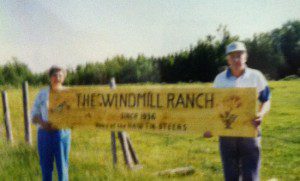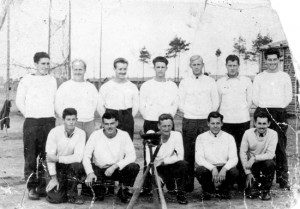
One of rancher Art Hawtin’s closest friends, another rancher in Beaverton, Ont., told me that Art had two personalities. One personality Art exhibited around family and friends, when he was soft-spoken and easy-going. Then, whenever he herded his cattle, he exhibited the firmness and purpose required. When he moved cattle into pens or onto trucks, his friend said, Art seemed to be able to speak to the animals with his eyes and his body posture.
“It was as if the cattle figured that it was their job to get into the chutes or onto the truck,” Bob Robertson told me this week. “Art made them do whatever he wanted.”
Art Hawtin was the fifth of six children born to John and Emily Hawtin at the family farm near Kinmount, Ont. There, though he worked first in father John’s lumber enterprise, as a youngster Art must have learned the ways of livestock management, not by books, not by instruction, but mostly by instinct. He seemed to have a sixth sense when it came to handling cattle. At his memorial the other day (at St. Andrew’s United Church in Beaverton) one of the photographs displayed by the family during the ceremony showed Art and his wife (of 66 years) Noreen holding a sign.
“The Windmill Ranch,” the sign read, “Home of the Hawtin steers, since 1936.”
Art Hawtin would have run cattle on those hundreds of acres of land in what is known as the Carden Plain area (east of Orillia and northwest of Lindsay) right through until the day he died last week on Dec. 9.
Except that the Second World War broke out in 1939, when Art was finishing high school. In the summer of 1941, Art and his older brother George drove to Hamilton to enlist in the air force. George trained as a pilot, Art as an RCAF navigator, since as Art noted in his letters home, he was “mathematically inclined and had common sense.” George flew 31 combat operations, won the Distinguished Flying Cross and came home safely. Art’s air war proved more treacherous, especially on the night of May 13, 1943.
“We made our bombing run,” Hawtin told me in 2011. “There were night fighters (enemy aircraft) around. A night fighter shot out a starboard engine. Second starboard engine hit. We got the order to bail out.”
Three, including pilot Hugh Beattie, died in the resulting explosion. Four survived, including Art Hawtin who was interrogated for three days, and then shipped to Stalag Luft III, from which The Great Escape would occur less than a year later. Yes, you can tell anybody you meet in Hollywood that one of the actual members of The Great Escape was central Ontario rancher Art Hawtin. When he joined X Organization (the Escape Committee) he became a so-called “penguin,” helping to disperse the sand from escape tunnel “Harry” for nearly a year.
“I carried excavated tunnel sand inside my pants,” Hawtin said. “I would take bags of sand to the theatre after hours. We dumped the sand through a trapdoor into the basement.”

It turned out the rancher from Beaverton was more athletic than just as a sand-dispersing penguin. At six-foot and 160 pounds, he excelled at track and field and baseball. In 1943, a local newspaper ran an excerpt of a letter his mother received from Stalag Luft III. “I was first in hop-step-and-jump at 38 feet; second in discus and cricket ball throw with 97 ½ feet and 296 feet respectively; third in broad jump at 18 feet 8 inches. I was crowned ‘Victor ludorum’ or ‘Camp Champ!’”
Circumstances – principally that he didn’t speak any German – prevented Art Hawtin from making the escapers’ list. It probably saved his life, since Hitler and the Gestapo ultimately executed 50 of the 80 men who broke out of the camp that night – March 24/25, 1944.
Perhaps the gift of his survival directed him into teaching when he came home in 1945. I’ve learned in the past couple of years – as I’ve travelled the country meeting people at my Great Escape presentations – that Hawtin was an exceptional math teacher. At the memorial, the other day, a woman proudly announced she was the only girl in his Grade 12 math class in 1965. She said he always directed questions to her in class.
“I asked him why,” she said. “He said he knew I always had the answer. That’s why I loved being in his class.”
Art Hawtin seemed to have that knack to excel, no matter what the conditions. He could adapt. And he knew how to get along with anybody fate threw his way, whether livestock, prisoners of war, students and (in my case) a historian looking for meaningful stories. As a communicator he scored A+ in every situation.
By the way, another of Art Hawtin’s legacies will be his 647-hectare Windmill Ranch in the Carden Plain are of Ontario, permanently preserved in the Nature Conservancy of Canada. Seems appropriate to commemorate a rancher, prisoner, teacher and champ.